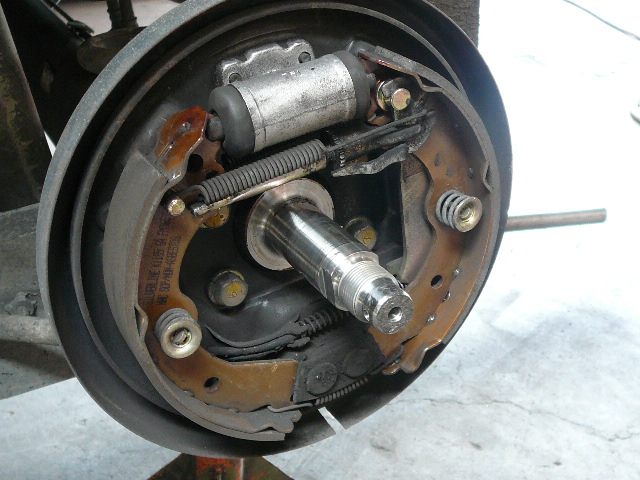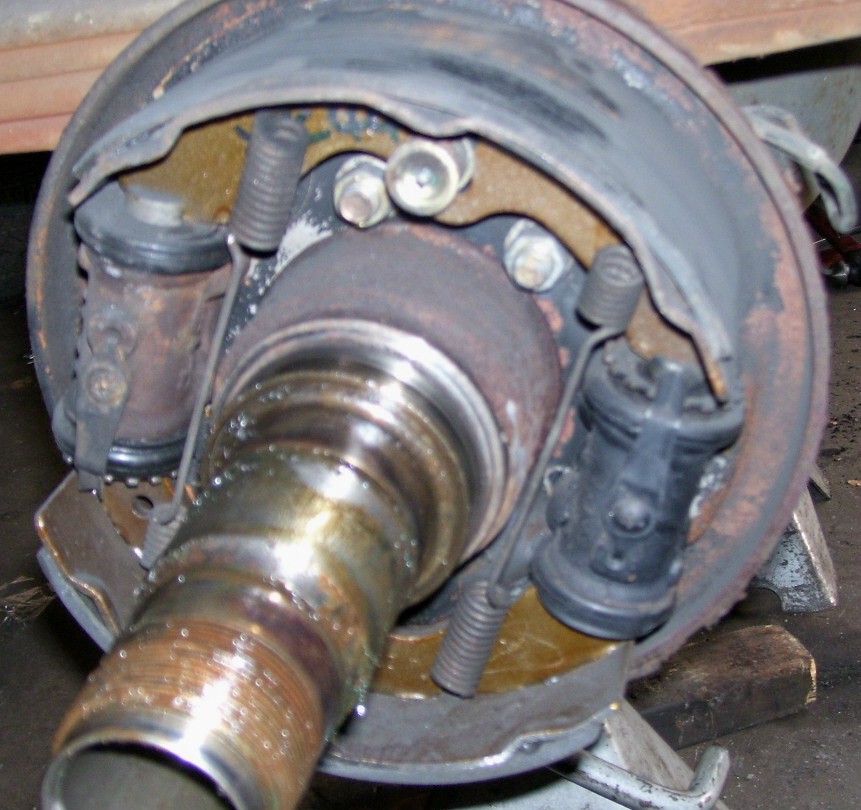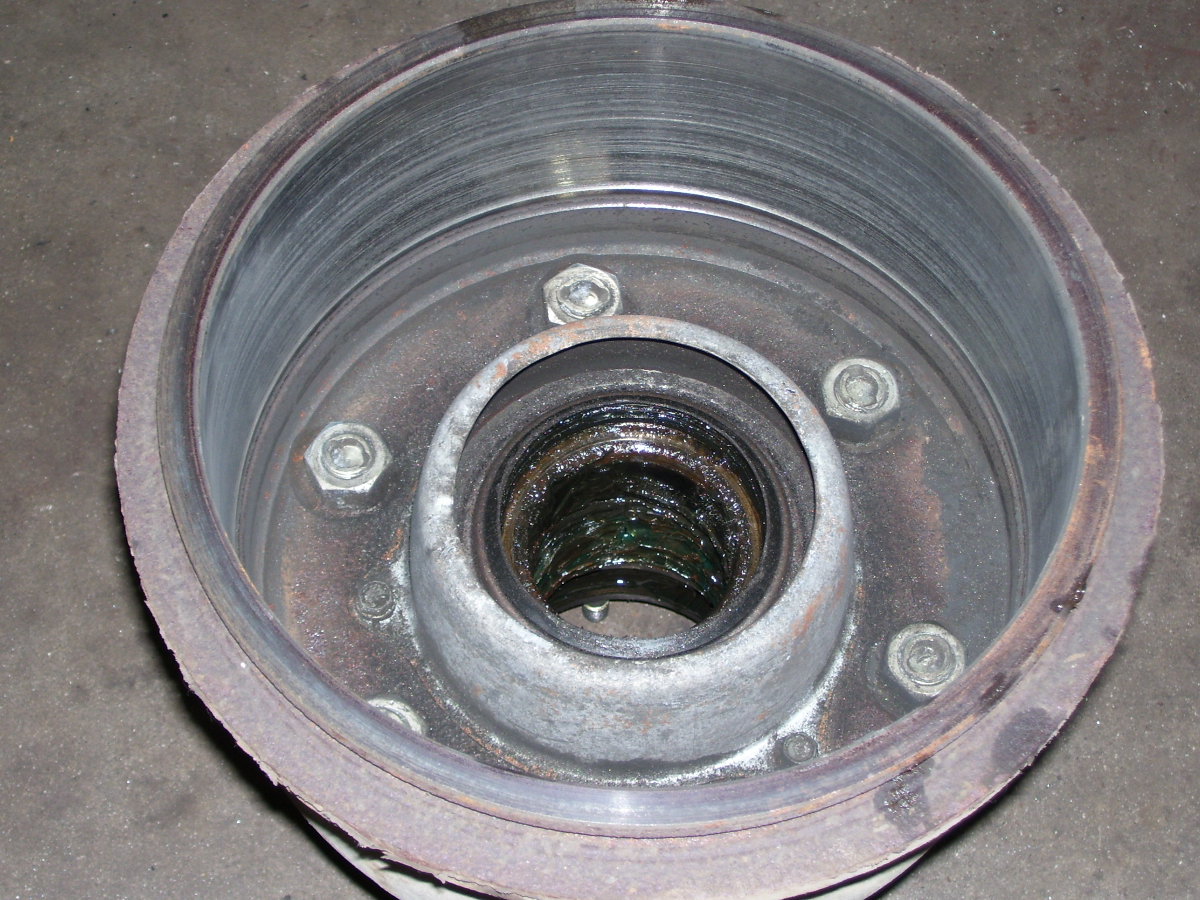| |
*YOU ARE HERE*
BRAKE REPAIRS CAR VAN TRUCK |
|
|
|
|
*YOU ARE HERE*
BRAKE REPAIRS |
|
|
|
|
|
|
|
|
|
|
|
|
|
|
|
|
|
|
GEDDES BRAKE LININGS & BRAKE DRUM
REPLACEMENT.
Geddes Automotive Auckland replace truck van & car brake linings. We remove brake drums to check and adjust brake linings.
HOW DO YOU REMOVE A REAR BRAKE DRUM OR A FRONT BRAKE DRUM?
Some reasons why front or rear brake drums are difficult to remove: the centre hole is a tight fit onto the axle, the centre of the drum has corroded and locked onto the axle hub face, the brake drum shoes (linings) have worn into the drum surface leaving lips which are now catching the brake linings and not slipping off.
If you have a stuck rear or front brake drum you need to wind off the adjustment on the
brake linings (brake drum shoes), sometimes applying a lubricant around the stud holes in the drum and around
the centre hole and allowing to soak for hours will usually allow the drum to come off. Sometimes we need to
use our large brake drum puller to get them free and sometimes it is a combination of all the above.
Geddes
have the equipment to remove all car brake drums, van & truck brake drums. We can check them for you to see if they can be machined or you need a front or rear brake drum replacement.
HOW DO YOU CHECK BRAKE LININGS?
Some front and rear brake drums backing plates have inspection holes. You can usually see the brake lining thickness through these holes.
HOW DO YOU CHECK BRAKE LININGS?
Continued below.
CLICK ON THE TYPE OF BRAKE REPAIR YOU REQUIRE: |
|
|
 |
Brake Linings & Cylinder mounted on Backing
Plate |
 |
Truck Brakes Linings & Cylinders. Below Truck Brake
Drum |
 |
| |
| |
|
*YOU ARE HERE*
BRAKE LININGS
&
DRUM BRAKE |
|
|
|
|
Some front and rear brake drums backing plates have inspection holes. You can usually see the brake lining thickness
through these holes.
It is always best to remove the front or rear brake drum so that you can see all of the brake linings, you can also
check the condition of the drums and wheel cylinders.
Geddes provide a FREE INSPECTION SERVICE (with conditions — we do not remove truck brake
drums free. We check 1 front brake and 1 rear brake of cars & vans FREE).
HOW DO YOU REPLACE BRAKE LININGS? (We strongly recommend you consult an expert or vehicle
catalogue before attempting any brake repairs. Cars falling off jacks and stands and failing to stop, have killed
many people.)
You need a reasonable amount of experience before I would attempt this brake repair or brake
check.
| |
1 |
Make sure the vehicle is on firm ground and reasonably level. Make sure the vehicle will not roll or slide. |
|
| |
2 |
Jack the vehicle and support the vehicle on sturdy stands. Before removing the wheels gently move the vehicle to make sure it will not fall off the stands. |
|
| |
3 |
Remove the wheels and brake drums. |
|
| |
|
NOTE: The brake dust can be harmful to your health. |
|
| |
4 |
Check the linings and gauge the amount of wear. The leading and trailing ends of the linings will usually be thicker than the middle area. If the linings have less than 1mm of thickness at any point it is time you consider replacing them. |
|
| |
5 |
Check for contamination on the brake drum & shoes (linings) – dust
or oil. |
|
| |
6 |
Gently pull the dust cap off the wheel cylinder at each end of the cylinder
and check for brake fluid. If the linings are in good order protect them against leaking wheel cylinders covering
them with oil. The oil can sometimes squirt out from under the dust caps under pressure. The surfaces under
the dust caps should only be moist not dripping. If oil is building up and is sufficient to drip then the cylinders
are worn and may require replacing. |
|
| |
7 |
If new linings are fitted it is always wise to replace the cylinders at the
same time and machine the
drums (we can machine them for you. Refer to our “BRAKE DISCS & BRAKE DRUM MACHINING” page). If
oil is already leaking from the cylinder seals chances are that once you fit new linings and the piston seals
act in a different area on the brake cylinder piston then it may not be long before your linings are destroyed
with brake fluid. |
|
| |
8 |
If you do take the linings off, make sure the linings are refitted the same
as when you took them off. |
|
| |
9 |
If you have replaced the wheel cylinders then you will need to bleed the brakes.
Refer to our brake hydraulic page for information on this procedure. |
|
ADJUSTING BRAKE LININGS (Brake drum adjustment) 1. Start by disconnecting the hand brake cables at the wheels.
| |
1 |
Start by disconnecting the hand brake cables at the wheels. |
|
| |
2 |
Make sure the brake linings are centralised — try fitting the brake drum, wind off the linings adjustment (brake drum adjustment) until the brake drum fits over the linings and wheel studs. |
|
| |
3 |
Once all of the drums are on pump the brakes a few times to centralise the drums. Wind
the adjustments up until the linings are just touching the drums. |
|
| |
4 |
Providing the brakes have been bled (if new wheel cylinders have been fitted), try the
brake pedal. If it feels spongy or has too much travel then they may need more brake drum adjustment and/or bleeding. |
|
| |
5 |
The wheels should still turn reasonably freely. Reconnect the hand brake cables but make
sure they are not dragging on the lever going into the backing plate. If they do not align without load then back
off the hand brake adjustments until they will connect without load. Make sure the wheels still turn with minimal
brake drag. |
|
| |
6 |
Put the vehicle back onto the ground and test the brakes before moving the vehicle
(the brake pedal must feel safe before driving) test the brakes from 1k per hour and faster to make sure the
brakes are working, foot and hand brake. |
|
| |
7 |
Once you have confidence that the brakes are working, go for a very short road
test – 1
block is enough. When you return jack the wheels off the ground and with the brakes released try spinning the
wheels again. There should only be a small amount of brake drag and the centre of the wheels must not be more
than warm to touch. If they are hot then they might have too much drag. |
|
| |
8 |
Sometimes to the non expert adjusting brakes can be difficult to get the balance of to
much adjustment (causing over heating and damage) and not enough adjustment and bad brakes. |
|
| |
9 |
On most modern vehicles the brakes will self adjust – providing the self
adjusters are working properly and have not been wound up too tight? |
|
BRAKE DRUM REPAIR
A brake drum repair is possible by a resurface or machine on our brake drum lathe so long as there will be sufficient metal left in the thickness of the drum after machining. We have email systems to search for replacement brake drums new and second hand. These are the best options to try first. A brake drum repair by welding and building up is possible but in our opinion this would be a last resort.
NOTE: If new linings are fitted and new wheel cylinders are not fitted and/or you do not have the brake drums machined then there is a high risk your brakes will still fail a WOF. New linings can sometimes bed into a poor brake drum surface but that takes time (kilometres of brake use) so if you need a WOF now its best to do it right first time. |
|



